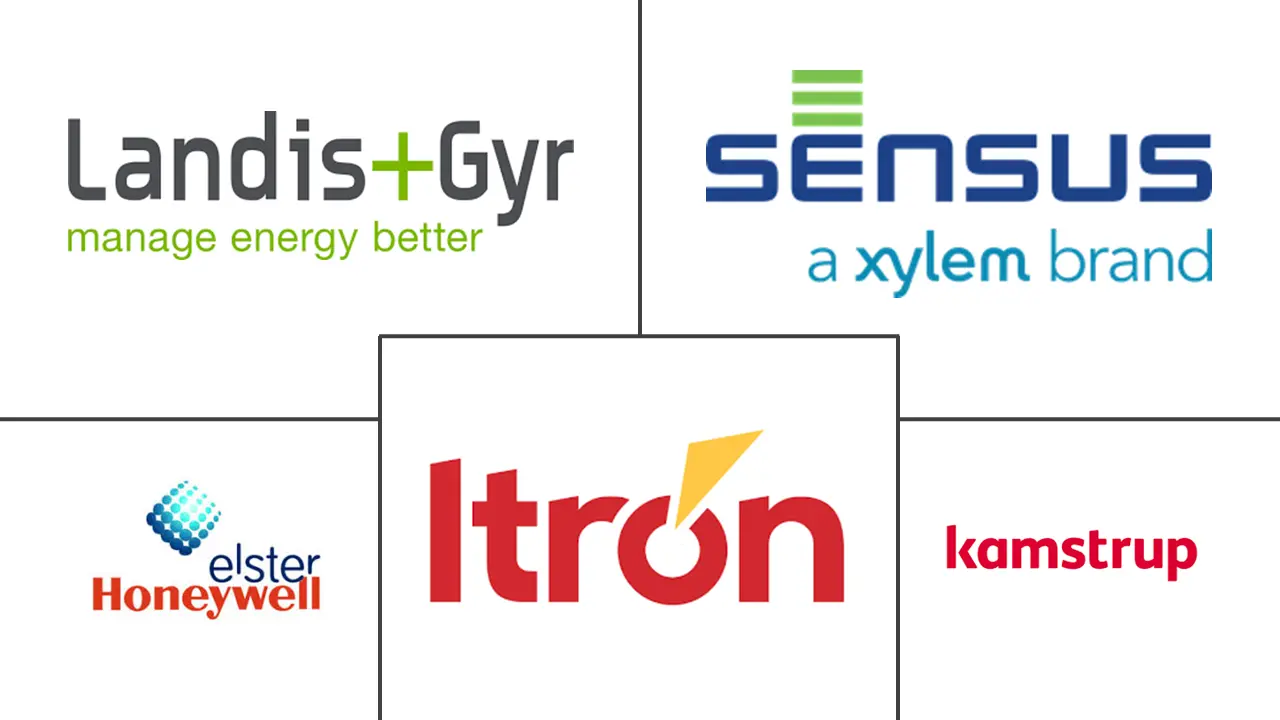Smart Lighting Market Size and Share

Smart Lighting Market Analysis by Mordor Intelligence
The smart lighting market size is estimated at USD 22.98 billion in 2025 and is forecast to reach USD 56.63 billion by 2030, reflecting a vigorous 19.77% CAGR. This trajectory is underpinned by accelerating installations across residential, commercial, and industrial sites as regulators tighten energy-efficiency mandates and LED component costs decline. Building owners now view connected lighting as a strategic platform that lowers electricity bills, supports data-driven facility management, and enhances occupant experience. Vendors are integrating edge AI and cloud analytics to differentiate offerings, while governments expand net-zero codes that require advanced controls from project inception. Growth opportunities are especially pronounced in Asia-Pacific, where urbanization and policy incentives create scale advantages for manufacturers.
Key Report Takeaways
- By product type, Smart Lamps and Fixtures led with 64.9% of smart lighting market share in 2024; Control Systems are advancing at a 22.1% CAGR through 2030.
- By installation type, retrofit projects commanded 52.1% share of the smart lighting market size in 2024, whereas new construction is projected to expand at a 21.3% CAGR between 2025-2030.
- By connectivity, Wi-Fi-based products held 37.8% revenue share in 2024; Zigbee solutions are set to rise at a 19.3% CAGR to 2030.
- By end-user, commercial facilities accounted for 42.5% of 2024 demand, while industrial sites exhibit the highest 20.7% CAGR through 2030.
- By geography, Europe retained 26.4% revenue share in 2024; Asia-Pacific is forecast to grow at a 19.8% CAGR over the same period.
Global Smart Lighting Market Trends and Insights
Drivers Impact Analysis
| Driver | (~) % Impact on CAGR Forecast | Geographic Relevance | Impact Timeline |
|---|---|---|---|
| Expanding smart-home ecosystem integration | +4.2% | Global; early North America and EU | Medium term (2-4 years) |
| Rapid LED cost reductions improve ROI | +3.8% | Global; strongest Asia-Pacific emerging markets | Short term (≤ 2 years) |
| Utility-funded demand-side-management incentives | +3.1% | North America and EU | Short term (≤ 2 years) |
| National net-zero building codes (2025-30 roll-outs) | +2.9% | EU, North America, select Asia-Pacific | Long term (≥ 4 years) |
| Li-Fi-enabled lighting pilots in warehouses | +1.7% | Industrial hubs in developed markets | Long term (≥ 4 years) |
| Edge-AI-powered adaptive dimming algorithms | +2.1% | Commercial and industrial worldwide | Medium term (2-4 years) |
| Source: Mordor Intelligence | |||
Expanding Smart-Home Ecosystem Integration
Smart lighting systems now anchor whole-home automation platforms. The Matter standard removes proprietary barriers, letting devices from different brands communicate through unified apps. Philips Hue’s tie-in with Samsung SmartThings synchronizes lighting, entertainment, and security under a single dashboard. Thread 1.4 will let border routers from varied vendors share a network, a milestone that strengthens consumer confidence in future-proof investments.
Rapid LED Cost Reductions Improve ROI
Advances such as flip-chip packages deliver 20% higher efficacy while preserving 100,000-hour lifespans, lowering maintenance costs for high-bay sites. Chip-on-board strips add installation flexibility that is reshaping 2025 product portfolios. Combined with utility rebates, these cost declines are compressing payback periods to well under 18 months in many commercial retrofits, as shown by the AirPark North project saving USD 4,990 annually.
Utility-Funded Demand-Side-Management Incentives
About 77% of US postal codes now qualify for LED rebates, and Con Edison’s instant incentives can slash project costs by up to 90% through 2025.[1]Con Edison, “Instant Lighting Incentives,” coned.com Because lighting can account for 60% of a building’s electricity, these programs accelerate smart lighting market adoption in cost-sensitive sectors.
National Net-Zero Building Codes (2025-30 Roll-Outs)
Policies such as the 2022 California Energy Code mandate high-efficacy luminaires with automated daylight harvesting and occupancy sensors.[2]Energy Code Ace, “2022 Building Energy Efficiency Standards,” energycodeace.comWith buildings consuming nearly 40% of global energy, connected lighting capable of 75% electricity cuts is central to net-zero strategies.
Restraints Impact Analysis
| Restraint | (~) % Impact on CAGR Forecast | Geographic Relevance | Impact Timeline |
|---|---|---|---|
| Cyber-security vulnerabilities in wireless protocols | −2.8% | Global; enterprise and government | Short term (≤ 2 years) |
| Fragmented inter-operability standards | −2.1% | Global; multi-vendor sites | Medium term (2-4 years) |
| Supply-chain volatility in rare-earth phosphors | −1.6% | Global; APAC manufacturing | Short term (≤ 2 years) |
| Smart-home privacy regulation uncertainty | −1.3% | EU and North America | Long term (≥ 4 years) |
| Source: Mordor Intelligence | |||
Cyber-Security Vulnerabilities in Wireless Protocols
Researchers showed that Zigbee Light Link devices can be hijacked through default keys, enabling lateral attacks on corporate networks. Check Point further demonstrated that compromised Philips Hue bulbs provide a beachhead into wider IT systems. [3]Philips Hue (Signify), “Hue x SmartThings Integration,” signify.com Resulting remediation costs and liability risks deter rapid adoption in security-critical environments.
Fragmented Inter-Operability Standards
Although Matter promises cross-brand control, early deployments reveal reliability gaps when devices move across ecosystems, forcing users back to proprietary hubs . Full Thread 1.4 support will not be ubiquitous until 2026, prolonging buyer hesitation for large, multi-vendor rollouts.
Segment Analysis
By Product Type: Control Systems Drive Intelligence Premium
Control Systems are forecast to grow at 22.1% CAGR, while Smart Lamps and Fixtures retained a 64.9% share of the smart lighting market in 2024. Control platforms blend sensors, analytics, and cloud dashboards, delivering recurring software revenue and margins that beat commodity lamps. Acuity Brands’ USD 1.215 billion QSC acquisition expanded its Intelligent Spaces Group and lifted segment revenue 14.5% in Q1 2025.
These systems use edge AI to predict occupancy patterns, driving energy savings that often exceed 50%. Industrial sites leverage the data stream to optimize workflow, highlighting a strategic pivot from hardware to insights. In contrast, Smart Lamps and Fixtures serve as the physical layer yet face price pressure as LED costs fall and volumes scale.
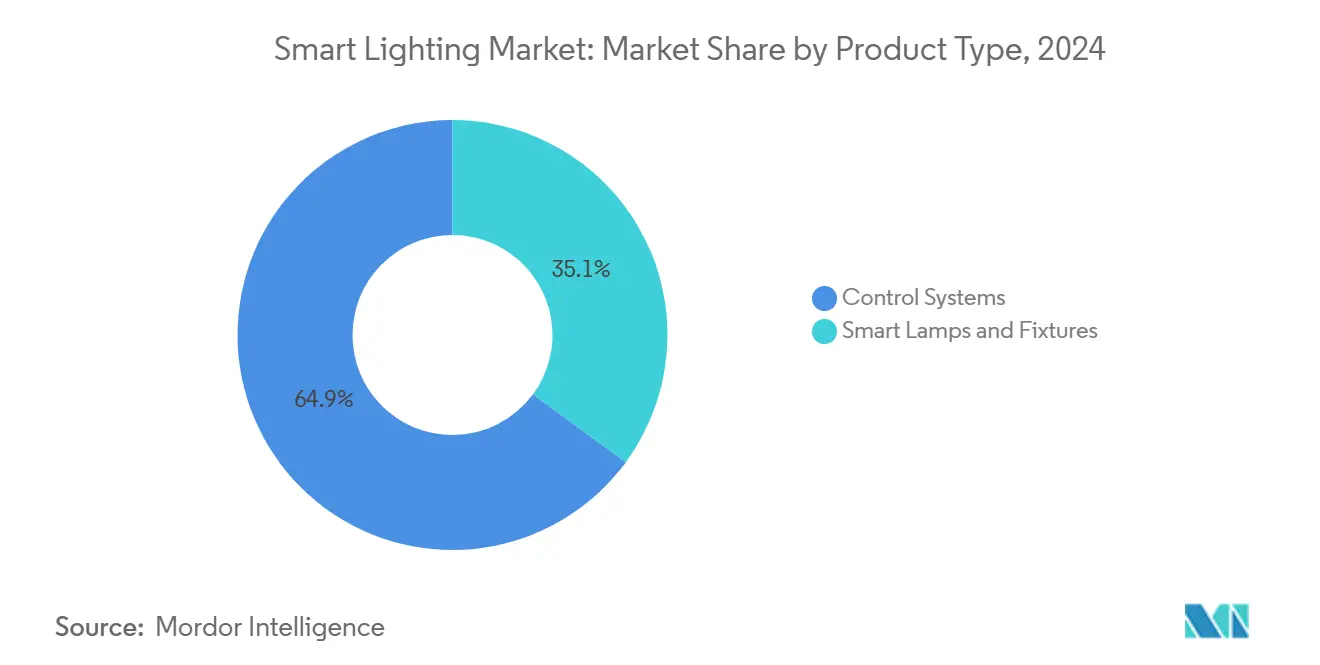
Note: Segment shares of all individual segments available upon report purchase
By Installation Type: Retrofit Dominance Shifts Toward New Construction
Retrofit projects commanded 52.1% of the smart lighting market size in 2024 due to a vast base of legacy luminaires. Utility incentives and short payback periods keep this segment attractive, as seen when the Australian Taxation Office cut lighting costs 94% via a retrofit.
New construction adoption is rising at a 21.3% CAGR because architects are embedding intelligent lighting from the blueprint stage. California’s 2022 code requires advanced controls in all new builds. Ground-up installations also unlock functions such as Li-Fi and dense sensor grids that are cumbersome to retrofit later, tilting long-term value toward this segment.
By Connectivity Technology: Zigbee Gains Ground Despite Wi-Fi Leadership
Wi-Fi accounted for 37.8% of connectivity revenue in 2024, reflecting existing LAN infrastructure and consumer familiarity. Zigbee is closing the gap at 19.3% CAGR as its mesh topology and low power draw suit large-footprint deployments.
The connectivity mix is shifting toward multi-protocol chips that fluidly bridge Wi-Fi, Zigbee, Bluetooth, and emerging Thread stacks. Vendors plan Matter-ready firmware updates that let luminaires auto-select the optimal path, a design that minimizes lock-in risk and supports seamless expansion across facility zones.
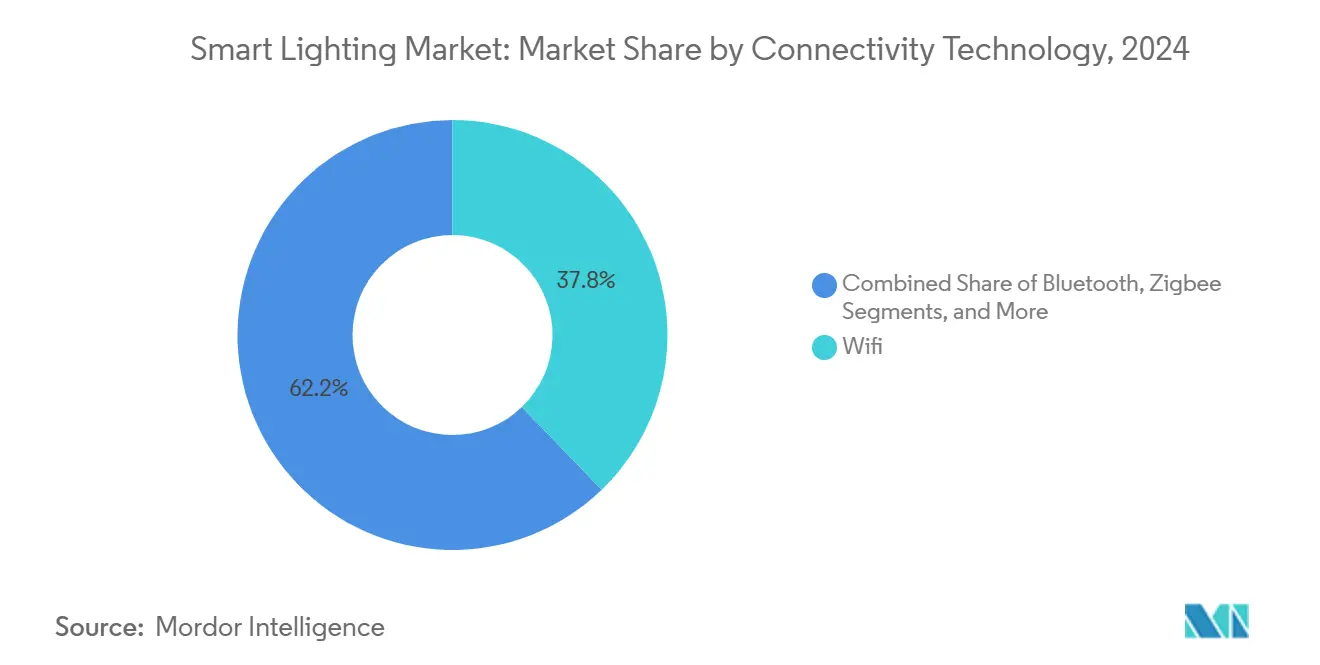
Note: Segment shares of all individual segments available upon report purchase
By End-User: Industrial Segment Accelerates Past Commercial Leadership
Commercial sites held 42.5% of 2024 demand, using connected lighting mainly for utility savings and occupant comfort. Offices typically shave 25-40% electricity through automated dimming. Industrial facilities are the fastest-growing user group at 20.7% CAGR. They deploy sensors for asset tracking and Li-Fi to exchange data with robotic tools, achieving sub-millisecond latency that supports Industry 4.0 workflows. With energy cuts reaching 50% and annual savings have increased significantly, factories view smart lighting as both an operational and strategic asset.
Geography Analysis
Europe preserved 26.4% of revenue in 2024 due to strict efficiency codes and mature automation demand. German retrofits such as the VIVARES Zigbee upgrade qualified for KfW276 subsidies, evidencing policy-driven momentum. Government grants and carbon targets sustain continued adoption, particularly in public buildings and premium office space.
Asia-Pacific is the fastest mover with a 19.8% CAGR. China implemented eight new lighting standards in 2024 that raise efficacy thresholds and push connected controls, spurring domestic manufacturers to scale smart product lines. India’s Bright Road program aims to replace traditional bulbs in 186 cities, steering large-scale procurement toward networked LED systems. Regional trade fairs such as Hong Kong’s Autumn Lighting Fair showcased 3,000 exhibitors focusing on smart-city lighting, underscoring robust supply-chain expansion
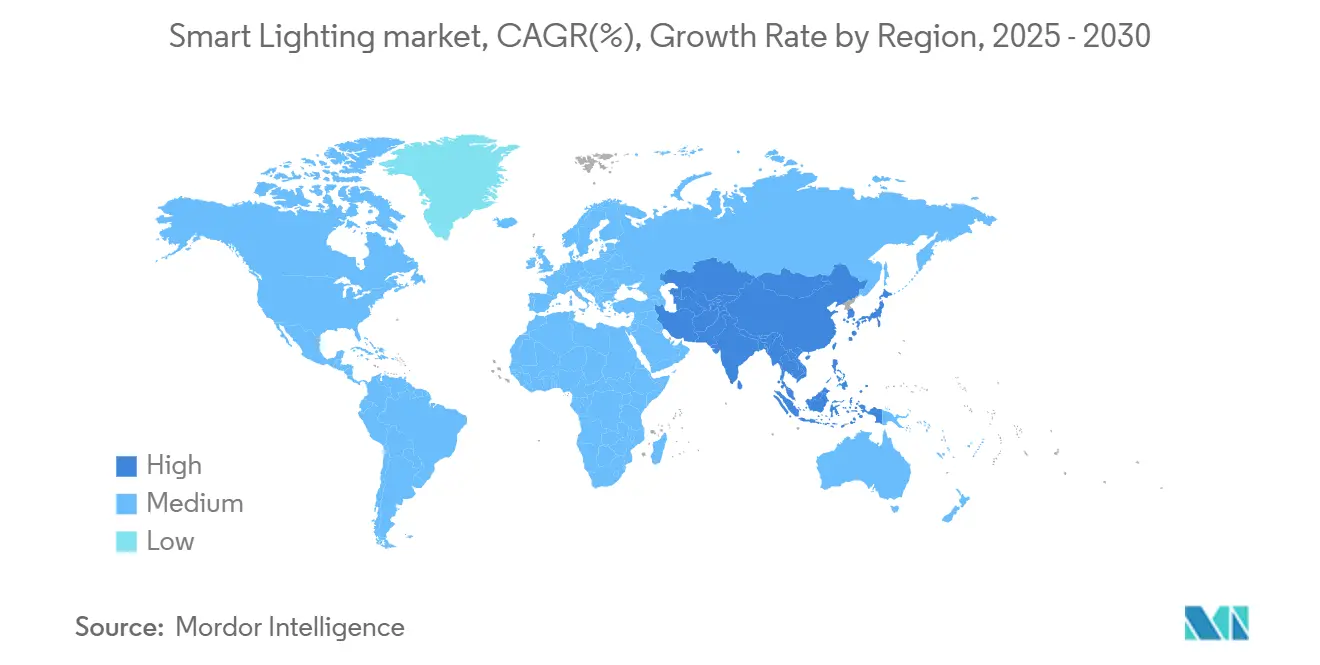
Competitive Landscape
The smart lighting market remains moderately fragmented yet is consolidating as vendors pursue software depth and vertical integration. Signify launched a EUR 150 million share repurchase, signaling confidence as connected and specialty lighting rises to 30% of its mix. Acuity Brands’ QSC buyout broadened its audio-video-control stack, making software and services two-thirds of Intelligent Spaces revenue.
Technology differentiation now rests on AI features and ecosystem ties. Philips Hue introduced a generative-AI assistant that adapts scenes and detects smoke-alarm signals, translating hardware into subscription-driven value. Smaller challengers gain ground by launching Matter-compliant fixtures that slot into popular platforms without proprietary hubs, eroding legacy channel control. Meanwhile, industrial specialists package Li-Fi and sensor analytics to command premium pricing in niche applications like high-speed robotic data links.
Competitive pressure is also visible in manufacturing. The Dixon Technologies-Signify joint venture scales production in India to address booming regional demand and export opportunities. OEM collaborations and ODM expansions are common as brands balance cost efficiency with the localization mandates found in many public tenders.
Smart Lighting Industry Leaders
-
Signify N.V.
-
Acuity Brands Inc.
-
Hubbell Inc.
-
Eaton Corp.
-
Lutron Electronics Co. Inc.
- *Disclaimer: Major Players sorted in no particular order
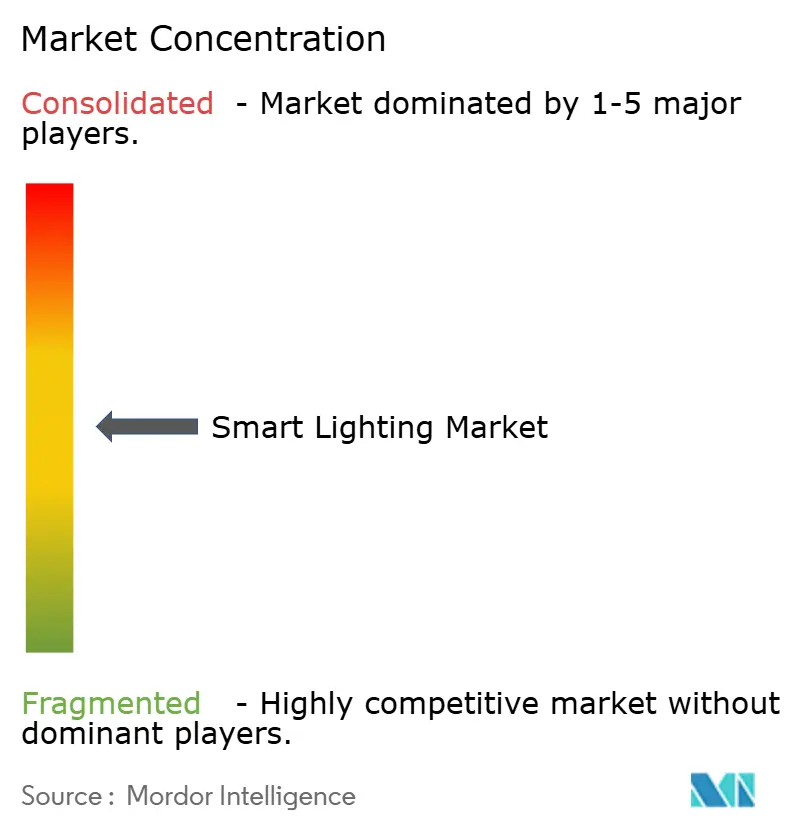
Recent Industry Developments
- June 2025: Dixon Technologies and Signify established a 50:50 joint venture to manufacture lighting products in India.
- May 2025: Signify posted solid Q1 2025 results, noting that connected lighting now delivers roughly 30% of total revenue.
- January 2025: Acuity Brands finalized its USD 1.215 billion purchase of QSC, expanding its cloud-managed audio and control portfolio.
- January 2025: Philips Hue launched AI-powered features including a generative assistant and smoke-alarm detection.
Research Methodology Framework and Report Scope
Market Definitions and Key Coverage
Our study defines the smart lighting market as revenue generated from connected lamps, luminaires, sensors, gateways, and lighting-management software that enable remote, automated, or data-driven control across residential, commercial, industrial, and outdoor settings. Products must employ addressable wired or wireless protocols and ship as finished goods, not discrete LEDs or generic drivers.
Scope exclusion: stand-alone, non-networked LED fixtures and legacy incandescent or fluorescent lamps are kept outside the model.
Segmentation Overview
- By Product Type
- Control Systems
- Smart Lamps and Fixtures
- By Installation Type
- New Construction
- Retrofit
- By Connectivity Technology
- Wi-Fi
- Bluetooth
- Zigbee
- Others
- By End-User
- Residential
- Commercial
- Industrial
- Others
- By Geography
- North America
- United States
- Canada
- Mexico
- South America
- Brazil
- Argentina
- Rest of South America
- Europe
- Germany
- United Kingdom
- France
- Italy
- Spain
- Rest of Europe
- Asia-Pacific
- China
- India
- Japan
- South Korea
- Australia and New Zealand
- Rest of Asia-Pacific
- Middle East and Africa
- Middle East
- Saudi Arabia
- United Arab Emirates
- Turkey
- Rest of Middle East
- Africa
- South Africa
- Nigeria
- Egypt
- Rest of Africa
- Middle East
- North America
Detailed Research Methodology and Data Validation
Primary Research
Mordor analysts interviewed fixture makers, control-system suppliers, city facility managers, and major electrical wholesalers across North America, Europe, Asia-Pacific, and the Middle East. These discussions validated penetration assumptions, average selling prices, retrofit pace, and expected smart-control attach rates, which sharpened the desk-research baselines.
Desk Research
We began with public datasets from agencies such as the International Energy Agency, Eurostat, and the US Energy Information Administration to size installed lighting stock and energy-efficiency policies. Trade bodies like LightingEurope, the Connected Lighting Alliance, and regional smart-city programs supplied adoption rates, while company 10-Ks, investor decks, and patent libraries added pricing and technology cadence. Subscription tools, D&B Hoovers for corporate revenues and Dow Jones Factiva for global deal flow, helped triangulate channel values. The sources listed illustrate our approach and are not exhaustive; many additional references informed the analysis.
Market-Sizing & Forecasting
A top-down reconstruction started with national building floor area and street pole counts, moved through LED penetration and smart-control attachment, and landed on shipments valued at prevailing ASPs. Supplier roll-ups and sampled project invoices offered bottom-up checkpoints, allowing our team to adjust outliers. Key variables include retrofit ratio, sensor attach price premium, utility rebate intensity, Matter protocol uptake, and smart-city budget trends. Forecasts employ multivariate regression blended with scenario analysis, using GDP growth and electricity tariff outlooks as leading indicators. Gaps in regional channel data are bridged by expert-validated ratios drawn from comparable markets.
Data Validation & Update Cycle
Outputs pass variance checks against historical import data and vendor earnings, then undergo peer review. Reports refresh annually; material events, policy shifts, landmark procurements, and disruptive M&A trigger interim revisions, and a final analyst sweep ensures clients receive the latest view.
Why Mordor's Smart Lighting Baseline Commands Reliability
Published figures vary because firms choose differing product baskets, price bases, and refresh cadences. Our disciplined scope, multi-source variables, and yearly update rhythm temper volatility and keep numbers actionable for planners.
Key gap drivers include whether controls and software are counted, how retrofit activity is captured, and the rigor of primary validation. Others may rely on linear extrapolation or bundle wider IoT devices, which pulls totals apart from real smart lighting spend.
Benchmark comparison
| Market Size | Anonymized source | Primary gap driver |
|---|---|---|
| USD 22.98 B (2025) | Mordor Intelligence | |
| USD 9.86 B (2025) | Global Consultancy A | Focuses on connected bulbs only, omitting fixtures and controls |
| USD 18.00 B (2025) | Industry Research B | Applies uniform growth from a pandemic low with limited field checks |
| USD 34.43 B (2025) | Trade Journal C | Bundles smart home hubs and IoT services, inflating lighting revenue |
The comparison shows that, by selecting a clear scope and balancing top-down modeling with ground feedback, Mordor delivers a transparent, dependable baseline that decision-makers can trace back to tangible market drivers.
Key Questions Answered in the Report
What is the current size of the smart lighting market?
The smart lighting market is valued at USD 22.98 billion in 2025 and is projected to expand rapidly at a 19.77% CAGR to 2030.
Which product category is growing fastest?
Control Systems are the fastest-growing segment, posting a 22.1% CAGR as buildings seek integrated management platforms that go beyond basic illumination.
Why is Asia-Pacific the most dynamic region?
Large-scale urbanization, government LED mandates, and new national standards are propelling Asia-Pacific growth at a 19.8% CAGR, outpacing Europe and North America.
How do utility incentives influence adoption?
Programs such as Con Edison’s instant rebates can cut installation costs by up to 90%, shortening payback periods and accelerating commercial and industrial upgrades.
Page last updated on:
